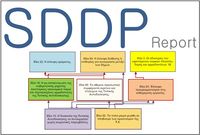|
Executive Summary
The SDDP co-laboratory ‘Safer Internet Day 2009’ documented here built on experiences gained from previous relevant training sessions in Bruges, Stockholm, and Limassol as well as the results of the 6-month evaluations (Customer Satisfaction Surveys) performed by the coordinating node.
The co-laboratory was dealing with sharing and developing ideas, projects, initiatives, and methods that nodes can take either locally or jointly at the European level in order to organize a successful and well attended Safer Internet Day 2009. Participants collected and exchanged as much information and knowledge as possible to be used accordingly by the nodes so as to organize Safer Internet Days 2009 in all Insafe nodes across Europe.
This co-laboratory, therefore, defined an action plan; the triggering question that was tackled in this co-laboratory was:
What actions can nodes take either locally or jointly at the European level in order to organize a successful / well attended Safer Internet Day 2009?
Insafe nodes’ staff described 60 ideas and actions ahead of the co-laboratory and during the dialogue with the entire group. The participants altogether grouped these 60 ideas and actions into five categories based on common attributes among the ideas identified by the Nodes’ staff.
These categories were named the following:
- Competition
- Cooperation
- Promotion
- Basic Ideas
- Involving the Public
Each participant chose five factors that they thought were those most important. The voting results were used to select factors for the subsequent structuring phase to identify inter-relations among the generated actions.
Participants structured 13 ideas/actions. The 13 ideas/actions were structured within five levels and are related according to the influence they exert on each other. Those ideas/actions that appear lower in the Influence Map, are more influential in terms of influence than those at higher levels and are the ones to tackle preferentially.
The following Figure ‘SID 2009 – Influence Map’ shows the resulting influence tree:
According to the participants of this workshop, the action appear to be the most influential was:
Action #8: Learn from (un)successful events from all nodes
After having participated in the structured dialogue it was expected that:
- Participants would gain a deeper understanding of the complexity of the situation and the interconnections between “ideas”;
- Participants would have the opportunity to understand how the “others” may think or perceive the current situation or envision the “ideal” situation;
- A “voted” consensus between all participants taking part in the co-laboratory would emerge in the “influence tree” as a joint product.
Participants
| Name | Country |
|---|---|
| Julia Barlinska | Poland |
| Hlif Bodvarsdottir | Iceland |
| Nel Broothaerts | Belgium |
| Rita Astridsdotter Brudalen | Norway |
| Anna-Maria Drousiotou | Cyprus |
| Marko Eriksson | Finland |
| Stefaan Hendrickx | Belgium |
| Liene Kalna | Latvia |
| Stephanie Kutscher | Germany |
| Ajda Jerman Kuzelicki | Slovenia |
| Melinda Martino | Sweden |
| Teemu Ruohonen | Finland |
| Anna Rywczynska | Poland |
| Veronica Samara | Greece |
| Agnieszka Wrzesien | Poland |
| José Luis Zatarain | Spain |
